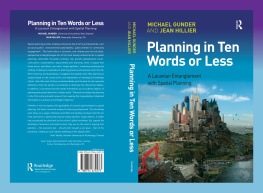First published 2011
by Routledge
2 Park Square, Milton Park, Abingdon, Oxon, OX14 4RN
Simultaneously published in the USA and Canada
by Routledge
270 Madison Avenue, New York, NY 10016
Routledge is an imprint of the Taylor & Francis Group, an informa business
This edition published in the Taylor & Francis e-Library, 2011.
To purchase your own copy of this or any of Taylor & Francis or Routledges collection of thousands of eBooks please go to www.eBookstore.tandf.co.uk.
2011 Phil Allmendinger
The right of Phil Allmendinger to be identified as author of this work has been asserted by him in accordance with sections 77 and 78 of the Copyright, Designs and Patents Act 1988.
All rights reserved. No part of this book may be reprinted or reproduced or utilised in any form or by any electronic, mechanical, or other means, now known or hereafter invented, including photocopying and recording, or in any information storage or retrieval system, without permission in writing from the publishers.
British Library Cataloguing in Publication Data
A catalogue record for this book is available from the British Library
Library of Congress Cataloging-in-Publication Data
Allmendinger, Philip, 1968
New Labour and planning : from New Right to New Left / Philip Allmendinger.
p. cm.
Includes bibliographical references and index.
1. Regional planningGreat Britain. 2. Labour Party (Great Britain) I. Title.
HT395.G7A55 2011
324.24107dc22 2010031309
ISBN 0-203-83199-3 Master e-book ISBN
ISBN13: 978-0-415-59748-7 (hbk)
ISBN13: 978-0-415-59749-4 (pbk)
ISBN13: 978-0-203-83199-1 (ebk)
NEW LABOUR AND PLANNING
Following the Thatcher and Major administrations there was an apparent renaissance of planning under New Labour. After a slow start in which Labours view of planning owed more to a neoliberal, rolled back state model reminiscent of the New Right, the government began to appreciate that many of its wider objectives, including economic development, climate change, democratic renewal, social justice and housing affordability, intersected with and were critically dependent upon the planning system. In England a new system of development plans was created, along with the notion of spatial planning, as a way of bringing together the fragmented landscape of governance towards a range of broad objectives, including sustainable development, urban renaissance and tackling climate change.
A wide range of initiatives, management processes, governance vehicles and policy documents emanated from government. Planning, like other areas of the public sector, was to be reformed and modernised and given a prime role in tackling national, high profile priorities such as increasing housing supply and improving economic competitiveness. The result was a hyperactive period of activity and change that had a variety of intended and unintended impacts as well as longer term implications for the way in which we think about planning and the role of the state.
But the experiences of Labour tell us more than how national governments succeed, or dont, in policy change. The Labour era also calls to attention the nature of planning itself and how sources of stability and change in the wider governance landscape react to and interpret change. Drawing upon an institutionalist framework, the book also seeks to understand how and in what circumstances change emerges, either in an evolutionary or a punctuated way. It will, for the first time, chart and explore the changing nature of development and planning over the Labour era while also stepping back and reflecting upon what such changes mean for planning generally and the likely future trajectories of reform and spatial governance.
Phil Allmendinger is a Fellow of Clare College and Professor of Land Economy at Cambridge University, UK.
For Claudia, Hannah, Lucia and Eleanor
ILLUSTRATIONS
Figures
Tables
Maps
PREFACE
This book is an account of the changes to planning during the New Labour era. Despite drawing upon a range of case studies, it will never be possible to capture fully the experiences and practices of planning over a relatively long period and across a diversity of places. The book is therefore and inevitably a partial and personal account. Those wishing to read a vituperative take on the New Labour years will be disappointed. Similarly, those who felt that planning emerged strengthened and reborn will also be frustrated. While I have attempted a balanced understanding, the theme running through the book is itself one of disappointment: a disappointment with the New Labour government and a disappointment with planning and planners. I include planning academics and the professional institute in that last category. Despite the investment of time and resources, and against a backdrop of significant development demand, the opportunity to reinvent planning was lost. The proposals emerging from the coalition government on planning can be summarised as less is more. They may be ideologically driven but they can be justified and defended by reference to experiences of the previous thirteen years.
New Labour was guilty of seeking to achieve too much and of not understanding how the system worked. But it was also highly dependent upon planners themselves to effect change. There are plenty of examples of innovative practices and outcomes. Equally, old practices die hard. Leadership and vision were lacking. The new totem of spatial planning advanced by the profession and academics was a chimera that, to paraphrase Aaron Wildavsky, was everything and nothing. It echoed New Labours own obsession with positive messages and inclusive discourses around sustainable development. Conflict and difficult choices, once the role of planning, were either replaced by consensus, partnership-based governance or passed on to multiple, arms-length enquiries. The depoliticisation of planning was merely a postponement of conflict. There cannot be winwinwin solutions in the messy, unequal and divergent real world. And so it turned out to be. By the time that this was realised it was too late. From 2008 the implications of the credit crunch on development activity began to be felt. Attention shifted, and planning was reorientated towards economic development and competitiveness.
The end of New Labour came in May 2010. There are a number of possible futures for planning under the coalition government. What planners and others need is to stand back and reflect critically upon the experiences and lessons of the New Labour era so as to help shape the future.
ACKNOWLEDGEMENTS
This book emerged over a long period and draws upon a wide range of research, some of which was undertaken with others. Particular acknowledgement and thanks should go to Graham Haughton and Mark Tewdwr-Jones, who have helped shape what follows in a number of ways. Jeremy Smalley has provided an invaluable sounding board and insightful input on my take on the evolution of planning over the years as well as being a great friend. Alan Prior and Cliff Hague at Heriot-Watt University helped shape my thoughts on planning when I was a student and then as a colleague.
Numerous others provided their time and input generously, and I would like to express my sincere thanks to: Simon Payne, John Summers and David Roberts at Cambridge City Council; Alex Plant and John Onslow of Cambridgeshire Horizons; Peter Studdert at South Cambridgeshire District Council; Robert Evans of Argent; Paul Wilmott, C. B. Richard Ellis and Adrian Gurney from Arup; Diana Chin, Pete Tyler, Helen Hartley, Kelvin MacDonald and Colin Lizieri at the University of Cambridge; Derek Hooper and Kate Mack of the Norton Radstock Regeneration Company; James Buxton of Bidwells; Rebecca McAllister at Hives Planning; Pat McAllister, Franz Frst, Michael Ball and Kathy Hughes at the University of Reading; and Mark Oranje at the University of Pretoria.












